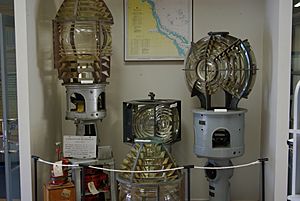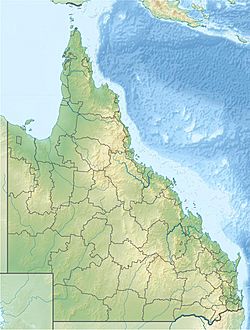Wharton Reef Light facts for kids
|
|
|
| Location | Townsville Queensland Australia |
|---|---|
| Coordinates | 19°15′35.82″S 146°49′18.44″E / 19.2599500°S 146.8217889°E |
| Year first constructed | 1915 (first) |
| Year first lit | 1990 (current) |
| Automated | 1915 |
| Deactivated | 1990 (first) |
| Construction | metal skeletal tower (first) fiberglass tower |
| Tower shape | square tower with balcony and lantern |
| Markings / pattern | bright red tower and lanten |
| Height | 30 feet (9.1 m) (first) 20 feet (6.1 m) (current) |
| Focal height | 56 feet (17 m) 46 feet (14 m) (current) |
| Intensity | 1,500 candela (irst) |
| Range | 13 nautical miles (24 km; 15 mi) (first) white: 10 nautical miles (19 km; 12 mi) (current) red: 7 nautical miles (13 km; 8.1 mi) (current) green: 7 nautical miles (13 km; 8.1 mi) (current) |
| Characteristic | Fl WRG 5s. |
| Admiralty number | K3226 (ex) |
| ARLHS number | AUS-265 |
The Wharton Reef Light is a lighthouse that is no longer in use. It used to stand on Wharton Reef, which is located in Princess Charlotte Bay off the Cape York Peninsula in Queensland, Australia. In 1990, the lighthouse was turned off and given to the Townsville Maritime Museum. You can now see it on display near the museum.
This lighthouse is special because it is the only one left from a group of twenty automatic lighthouses. These lighthouses were put up in Queensland between 1913 and the early 1920s. This time was known as the "Golden Age of Australian Lighthouses."
Contents
History of Australian Lighthouses
When Australia became a country in 1901, the government decided that it should be in charge of all lighthouses along the coast. In 1911, a law called the Lighthouses Act was passed. This law gave the government the power to take over the job of managing tools that help ships navigate.
The government officially took over this job on July 1, 1915. This was when the Commonwealth Lighthouse Service (CLS) was created. This time, from 1913 to the early 1920s, is often called the "Golden Age of Australian Lighthouses." The CLS took control of 104 lighthouses that had people working in them and 18 lighthouses that ran by themselves.
Building New Lighthouses
One of the most important jobs for the CLS was to light up the northern Inside Passage. This was a shipping route that went inside the Great Barrier Reef. At that time, there were only four lighthouses between the Torres Strait and Cooktown.
The CLS decided to put in twenty new lighthouses that would work completely by themselves. This decision was made because there weren't enough workers, building materials, or money during World War I.
How the Lighthouses Were Built
Most of these new lighthouses looked very similar. Their main difference was how tall they were. They were usually built on coral reefs or sandbars, which are not very stable. The base was usually a flat concrete slab with concrete poles holding up the structure.
The lighthouse itself was a simple metal frame with four legs. These frames were made in Brisbane. On top of the frame was a simple lantern with a small balcony. The light system was fully automatic. It used a special lamp that ran on compressed acetylene gas. A "sun valve" controlled when the light turned on and off.
The Original Wharton Reef Light
The Wharton Reef Light was one of the first lighthouses built in this series, in 1915. It was located on Wharton Reef, which was then called Dhu Reef. This reef is in Princess Charlotte Bay, west of Pipon Island. It is about 350 kilometres (220 mi) north of Cairns. This new lighthouse replaced an older marker on the reef.
Building the Wharton Reef Light was very difficult because of bad weather. The ground was also not stable, so they had to dig very deep for the foundations. The original lighthouse was about 50 feet (15 m) tall.
In 1959, the Wharton Reef Light was described as showing a white flash every three seconds. The light was very bright, with an intensity of 1,500 cd. It could be seen from about 13 nautical miles (24 km; 15 mi) away. The light was located at a height of 56 feet (17 m) above the water.

The lighthouse worked until 1990. At that time, the old metal structure was replaced by a new fibreglass hut. The light was also updated to a modern automatic beacon. The Wharton Reef Light was the last of its kind that was still working.
The federal Department of Transport gave the old tower to the Townsville Maritime Museum. It was taken apart and shipped to Townsville. In 1996, it was put back together in the middle of a traffic circle near the museum. It has been on display there ever since. The special Fresnel lens that was inside the lighthouse is now on display inside the museum, along with other lenses from the area.
The Current Light on Wharton Reef
The lighthouse that is currently on Wharton Reef was put in place on March 26, 1990. It is a white fibreglass hut. This hut sits on a small stainless steel structure, which is held up by concrete poles. The entire structure is 6 metres (20 ft) tall from the seabed to the top deck. The light itself is 14 metres (46 ft) above the water.
The current light flashes every five seconds. It can show white, red, or green light, depending on the direction a ship is coming from.
- Green light is shown between 84° and 97°. It can be seen for about 7 nautical miles (13 km; 8.1 mi).
- White light is shown between 97° and 126°, and again between 229° and 84°. It can be seen for about 10 nautical miles (19 km; 12 mi).
- Red light is shown between 126° and 229°. It can be seen for about 7 nautical miles (13 km; 8.1 mi).
The light uses solar power to run. It has a 12 Volt 35 Watt Halogen lamp. The white light is very bright, at 2,100 cd. The red and green lights are 420 cd. The Australian Maritime Safety Authority operates this light.
Visiting the Old Lighthouse
The original Wharton Reef Light tower is owned by the Townsville Maritime Museum. Both the museum site and the lighthouse display are managed by the Townsville City Council. You can easily visit the area where the lighthouse is displayed. However, you cannot go inside the tower itself.


